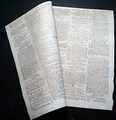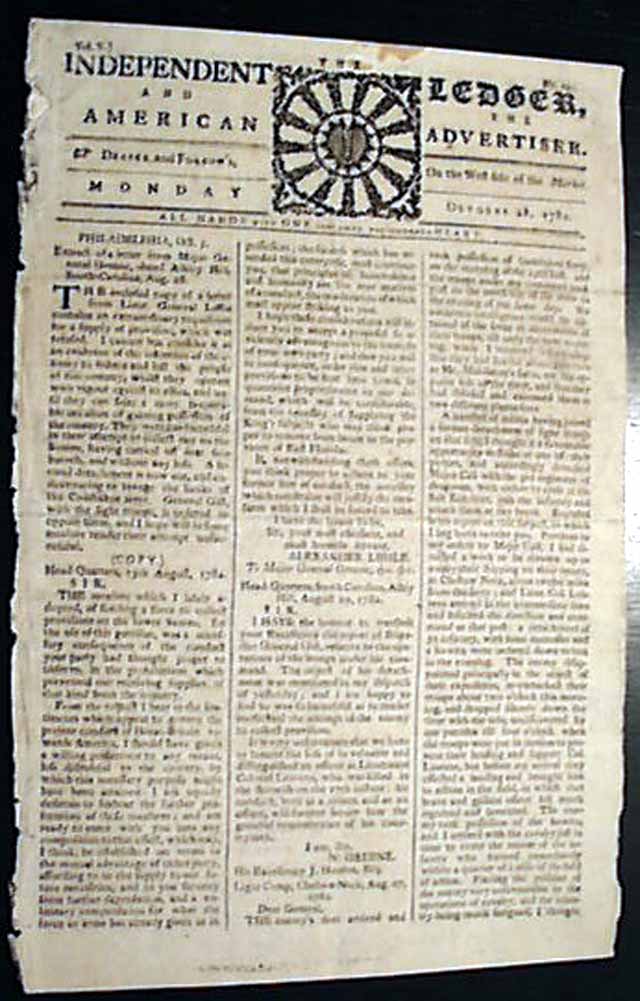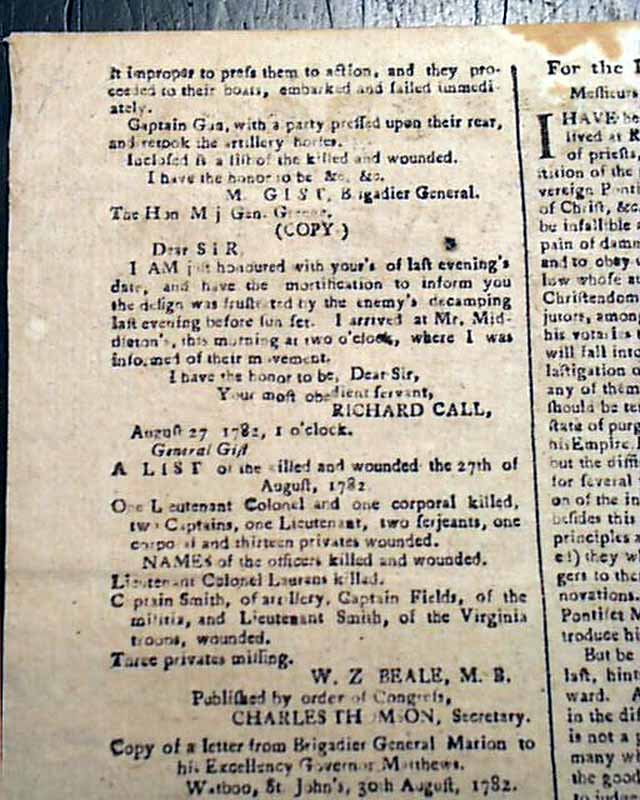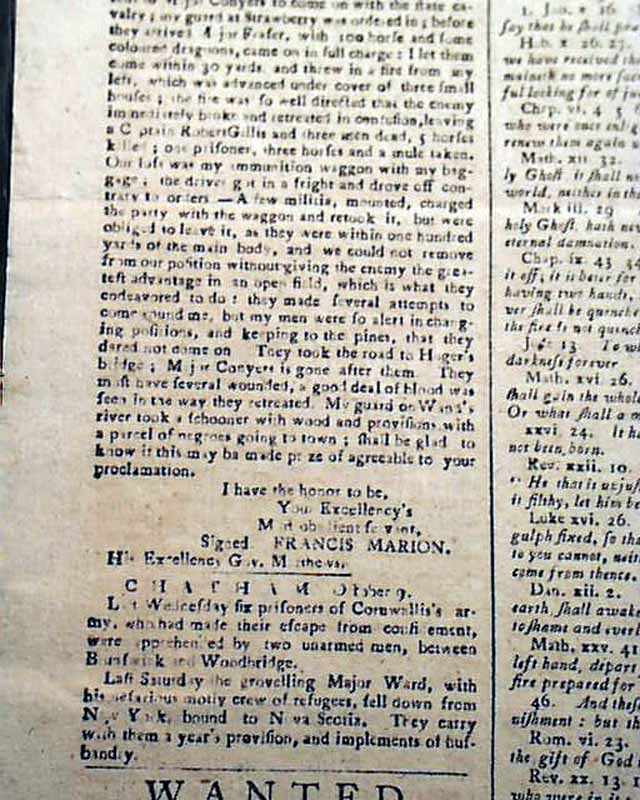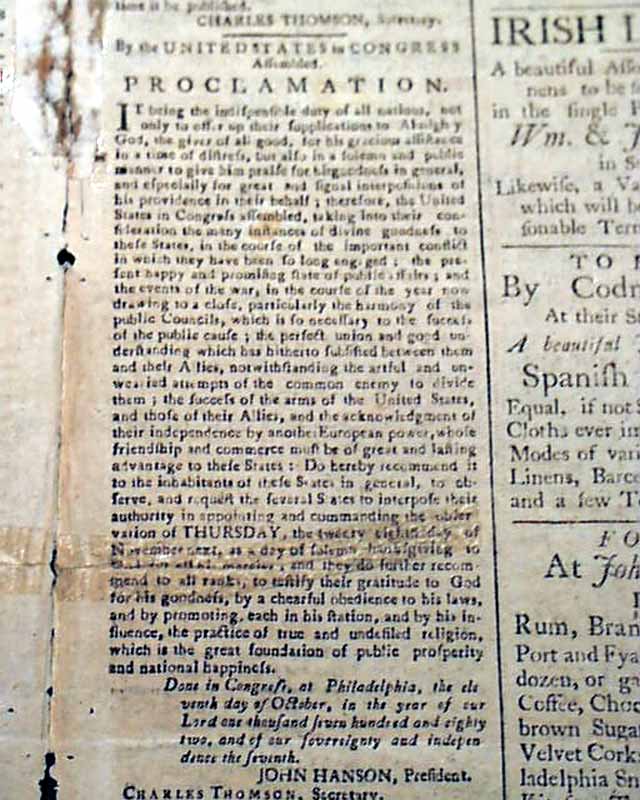Home >
Francis Marion, "The Swamp Fox", plus much more...
Francis Marion, "The Swamp Fox", plus much more...
Item # 701392
October 28, 1782
INDEPENDENT LEDGER, AND AMERICAN ADVERTISER, Boston, Oct. 28, 1782
* "The Swamp Fox" Francis Marion
* American Revolutionary War
* Great masthead engraving for display
One of the best features of this issue is the masthead engraving, which features a very patriotic theme: "All Hands with One Inflamed Enlightened Heart." signifying the 13 united colonies having a common, patriotic purpose. One of the more patriotic masthead engravings of the Revolutionary War era.
The front page has a letter from Gen. Greene in which he laments the loss of Lieut. Col. Laurens, signed in type: N. Greene. A second letter mentions Middletons Farm and describes the action which resulted in the death of Col. Laurens. It concludes on page 2 where there are two more related dispatches.
Also on page 2 is a letter about an engagement with the British near Bardos Farm, signed in type: Francis Marion. Page 2 also has a resolution issued by Congress stating that "...the right of making peace is vested in the...Congress; and by the Treaty of Alliance between His Most Christian Majesty and the United States...that neither...shall conclude peace...with Great Britain without consent of the other..." It concludes on page 3 where it is signed in type: Charles Thomson.
A page 3 "Proclamation" issued by Congress establishes Nov. 28 as a day of Thanksgiving, signed in type: John Hanson. Plus a resolve signed in type: John Hancock.
Four pages, inside has a non-archival mend in the resolution, and the proclamation, causing no loss of readability, A bit irregular near the top of the spine, otherwise in nice condition.
background: In August 1782, near Charleston, South Carolina, Francis Marion, the famed “Swamp Fox” of the American Revolution, engaged British forces in what would become his final military action. Intelligence had alerted Marion to a foraging expedition led by British Major Thomas Fraser, and he prepared an ambush along a cedar-lined avenue at the Wadboo Barony plantation. Marion’s militia, hidden behind trees and plantation outbuildings, waited until the British dragoons were within close range before opening fire, delivering a sudden and effective volley. The ambush inflicted several British casualties—approximately four killed and six wounded—while Marion’s men remained largely unscathed. However, low ammunition forced Marion to withdraw strategically toward the Santee River, demonstrating his hallmark guerrilla tactics of striking swiftly and retreating into the swamps. This engagement exemplified his mastery of irregular warfare and marked the end of his combat role in the Revolutionary War, cementing his legacy as a tactical genius who leveraged terrain and surprise to outmaneuver superior forces.
Also on page 2 is a letter about an engagement with the British near Bardos Farm, signed in type: Francis Marion. Page 2 also has a resolution issued by Congress stating that "...the right of making peace is vested in the...Congress; and by the Treaty of Alliance between His Most Christian Majesty and the United States...that neither...shall conclude peace...with Great Britain without consent of the other..." It concludes on page 3 where it is signed in type: Charles Thomson.
A page 3 "Proclamation" issued by Congress establishes Nov. 28 as a day of Thanksgiving, signed in type: John Hanson. Plus a resolve signed in type: John Hancock.
Four pages, inside has a non-archival mend in the resolution, and the proclamation, causing no loss of readability, A bit irregular near the top of the spine, otherwise in nice condition.
background: In August 1782, near Charleston, South Carolina, Francis Marion, the famed “Swamp Fox” of the American Revolution, engaged British forces in what would become his final military action. Intelligence had alerted Marion to a foraging expedition led by British Major Thomas Fraser, and he prepared an ambush along a cedar-lined avenue at the Wadboo Barony plantation. Marion’s militia, hidden behind trees and plantation outbuildings, waited until the British dragoons were within close range before opening fire, delivering a sudden and effective volley. The ambush inflicted several British casualties—approximately four killed and six wounded—while Marion’s men remained largely unscathed. However, low ammunition forced Marion to withdraw strategically toward the Santee River, demonstrating his hallmark guerrilla tactics of striking swiftly and retreating into the swamps. This engagement exemplified his mastery of irregular warfare and marked the end of his combat role in the Revolutionary War, cementing his legacy as a tactical genius who leveraged terrain and surprise to outmaneuver superior forces.
Category: Revolutionary War













